Is your closet overflowing? Clothes piling up that you no longer wear? It’s a common scenario, and instead of letting those garments gather dust, you can turn them into cash. Selling used clothes is not only a fantastic way to declutter your living space but also a savvy method to earn some extra income. Whether you’re looking to make a quick buck or start a more consistent side hustle, the market for pre-loved clothing is booming.
This guide will walk you through the best online and in-person platforms where you can sell used clothes for cash. We’ll explore various options, from user-friendly apps to established brick-and-mortar stores, providing you with the knowledge to choose the best route for your needs and maximize your returns. Let’s dive into the world of reselling fashion and discover how you can easily turn your unwanted items into cash.
Why Sell Your Used Clothes?
Beyond the obvious financial benefits, selling your used clothes offers a multitude of advantages. Firstly, it’s an incredibly effective way to declutter. A clean and organized closet can reduce stress and make getting dressed each day a more enjoyable experience. Selling clothes you no longer wear creates space for new items or simply a more minimalist lifestyle.
Secondly, it’s an environmentally conscious choice. The fashion industry is a significant contributor to global waste. By giving your clothes a second life, you’re participating in sustainable fashion, reducing textile waste, and lessening the environmental impact of constantly buying new items. You’re contributing to a circular economy where clothes are reused and valued for longer.
Finally, the used clothing market is substantial and growing. Consumers are increasingly seeking affordable and unique fashion options, and are more conscious of sustainable shopping. This demand creates a great opportunity for sellers to tap into this market and earn money from clothes they no longer need. Selling used clothes is a win-win: you gain financially and environmentally.
Top Online Platforms to Sell Used Clothes for Cash
The internet has revolutionized the way we buy and sell used clothes. Online platforms offer convenience, wider reach, and diverse options for sellers. Here are some of the best online marketplaces to consider:
1. eBay: The Classic Marketplace
Alt Text: Selling used clothes online on eBay marketplace platform for cash.
eBay, a veteran in the e-commerce world, remains a robust platform for selling almost anything, including used clothes. Its global reach and established user base make it a reliable option for both casual and serious sellers.
Fees: eBay’s fee structure involves an insertion fee (free for under 250 listings monthly) and a final value fee. For most clothing categories, the final value fee is 15% of the total sale amount for items sold at $2,000 or less. For items over $2,000, it’s 9%. Specific categories like athletic shoes and accessories have different fee percentages, so it’s crucial to check eBay’s selling fees page for the most accurate information for your items.
Shipping: eBay provides various shipping options, including USPS, FedEx, and UPS. Shipping costs are typically determined by package dimensions and weight. Sellers can also offer local pickup to avoid shipping altogether. You can choose to charge buyers for shipping or offer free shipping to attract more buyers – factor this into your pricing strategy.
Pros:
- Large Audience: Access to millions of potential buyers worldwide.
- Flexibility: Various listing formats (auction, fixed price), and control over pricing.
- Established Platform: Trusted and recognized platform with buyer and seller protection policies.
Cons:
- Competition: High competition due to the sheer volume of listings.
- Fees: While competitive, fees can impact profit margins, especially for lower-priced items.
- Time Investment: Creating listings, managing questions, and handling shipping can be time-consuming.
Best for: Sellers comfortable with online auctions and managing shipping, and those with a variety of clothing items to sell, from everyday wear to more unique pieces.
2. Vestiaire Collective: For Designer & Luxury Items
 A woman lounges in a chair while smiling and playing on her phone.
A woman lounges in a chair while smiling and playing on her phone.
Alt Text: Woman using Vestiaire Collective app on her phone to sell luxury used clothes online.
Vestiaire Collective caters specifically to the luxury and designer resale market. If you own high-end garments from brands like Gucci, Chanel, or Prada, this platform is designed to help you get the best return.
Fees: Vestiaire Collective has a tiered fee structure. They charge a 10% flat selling fee in most cases, but this can vary. For items priced at $100 or less, a flat $10 selling fee applies. For items over $20,000, a flat $2,000 fee is charged. Additionally, a payment processing fee of $3 for items up to $100 and 3% for items above $100 is applied. However, selling fees are sometimes waived for specific brands, which are listed on their website.
Shipping: Vestiaire Collective provides prepaid shipping labels, simplifying the shipping process for sellers. You are required to ship within seven days of a sale to avoid cancellation.
Pros:
- Luxury Focus: Specialized platform for designer brands, attracting buyers willing to pay premium prices.
- Authentication: Vestiaire Collective offers authentication services, building trust with buyers and ensuring the legitimacy of luxury items.
- Shipping Included: Prepaid shipping labels simplify logistics.
Cons:
- Higher Fees: Fees can be higher compared to general marketplaces, reflecting the premium services.
- Strict Requirements: Items must be authentic and in excellent condition to meet luxury market standards.
- Niche Market: Limited to designer and luxury brands, not suitable for everyday clothing.
Best for: Sellers with authentic designer and luxury clothing, handbags, and accessories in excellent condition looking to maximize their return in the high-end resale market.
3. ASOS Marketplace: Vintage & Independent Fashion

Alt Text: Online flea market concept, representing ASOS Marketplace for selling used vintage clothes.
ASOS Marketplace is geared towards vintage, independent, and boutique fashion. It’s a trendy platform associated with the popular online retailer ASOS, attracting a fashion-forward audience.
Fees: Currently, ASOS Marketplace is not accepting new seller applications. However, for existing boutiques, there are no listing fees, but a 20% commission fee is charged on sales.
Shipping: Sellers are responsible for shipping items within two days of payment clearance. Payment is received through PayPal or Stripe.
Pros:
- Trendy Audience: Attracts buyers interested in vintage and unique fashion.
- Brand Association: Benefits from the ASOS brand name and reach.
- No Listing Fees: For existing boutiques, no upfront costs for listing items.
Cons:
- Closed to New Sellers: Currently not accepting new applications, limiting accessibility.
- Commission Fee: 20% commission can be significant, impacting profit margins.
- Boutique Focus: More suited for sellers operating as small businesses or with a larger inventory of vintage or unique items.
Best for: Existing ASOS Marketplace boutique owners selling vintage, independent, or unique fashion items to a trend-conscious audience. Keep an eye on their website for updates on new seller applications.
4. Poshmark: Social Selling for Fashion Lovers
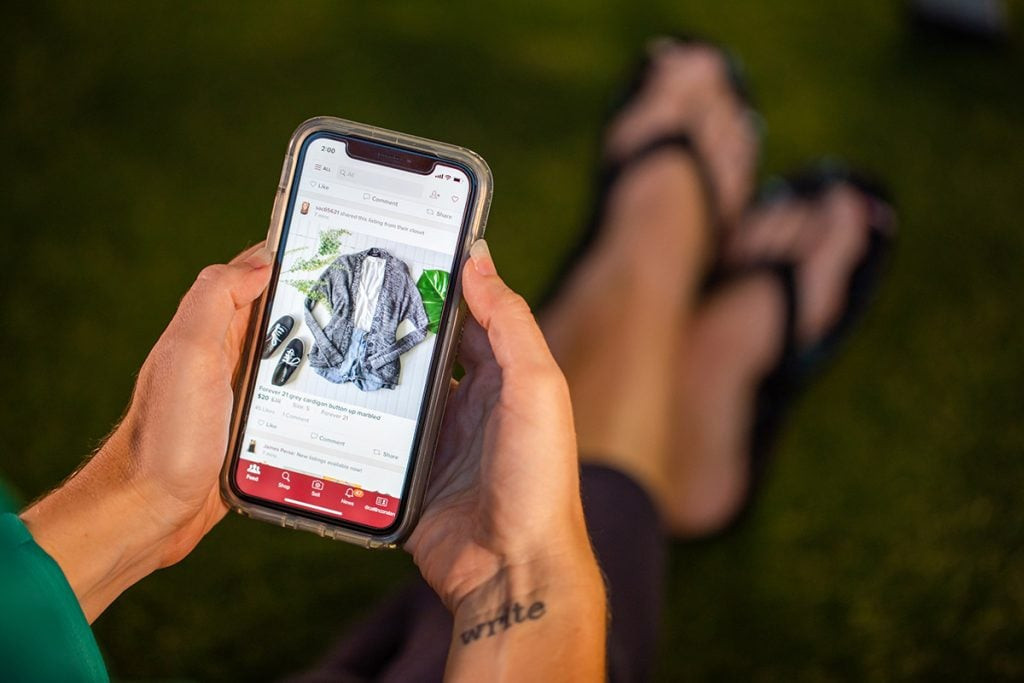 A woman holds a cell phone that is displaying the Poshmark app
A woman holds a cell phone that is displaying the Poshmark app
Alt Text: Woman using Poshmark app on her smartphone to sell used clothes online.
Poshmark is a social marketplace that emphasizes community engagement. It encourages sellers to participate in virtual “Posh Parties,” share fashion tips, and interact with buyers and other sellers.
Fees: Poshmark has simplified its fee structure. For items under $15, there’s a flat $1 fee. For items between $15 and $50, the fee is $2. For items over $50, it’s $3. Additionally, there’s a 5.99% fee on the order total (including price, shipping, and taxes).
Shipping: Poshmark provides prepaid, pre-addressed shipping labels for each order, simplifying the shipping process. For packages over five pounds, sellers need to upgrade the shipping label through the app.
Pros:
- Social Marketplace: Community features can help boost visibility and sales through interaction and sharing.
- Simplified Shipping: Prepaid labels streamline the shipping process.
- User-Friendly App: Mobile-first platform, easy to use for listing and managing sales.
Cons:
- Fees: While simplified, the tiered fee structure and percentage fee can still impact profits.
- Social Engagement Required: Maximizing sales often requires active participation in the Poshmark community.
- Lower Price Point Focus: Generally better suited for selling items at lower to mid-range price points.
Best for: Fashion-conscious individuals who enjoy social interaction and want a user-friendly mobile platform to sell used clothes, shoes, and accessories, particularly at accessible price points.
5. ThredUP: Convenient Clean-Out Service
 A woman emerges from her clothing wrack wearing a pink blazer.
A woman emerges from her clothing wrack wearing a pink blazer.
Alt Text: Woman holding a pink blazer, representing ThredUP’s mission to reduce fashion waste by selling used clothes.
ThredUP positions itself as a convenient solution for selling used clothes, focusing on reducing fashion waste. It offers a “clean-out kit” service that simplifies the selling process.
Fees & Payout: ThredUP operates on a consignment model. They send you a clean-out kit with a prepaid shipping label. You fill the bag with clothes and send it back. ThredUP inspects, photographs, lists, and sells the items for you. Payout percentages vary significantly based on the selling price. For items priced between $5 and $19.99, payouts range from 3% to 15%. For higher-priced items, the percentage increases, reaching up to 80% for items priced at $200 or more. Unsold items can be reclaimed (for a fee) or donated to ThredUP.
Shipping: ThredUP provides a prepaid shipping label for sending in your clean-out kit.
Pros:
- Convenience: Hands-off selling process – ThredUP handles listing, photography, and shipping.
- Sustainability Focus: Aligns with eco-conscious selling, reducing textile waste.
- Easy Clean-Out: Simplifies decluttering with the clean-out kit service.
Cons:
- Low Payouts: Consignment model results in significantly lower payouts compared to selling directly.
- Slow Process: The entire process, from sending in clothes to receiving payment, can take months.
- Limited Control: Sellers have limited control over pricing and item descriptions.
Best for: Individuals prioritizing convenience over maximizing profit, who want a hassle-free way to declutter and are comfortable with consignment payouts and a longer selling timeline. Good for bulk selling of everyday clothing brands.
ThredUP Payout System
| Sales Price | Payout Percentage |
|---|---|
| $5 to $19.99 | 3% to 15% |
| $20 to $49.99 | 15% to 30% |
| $50 to $99.99 | 30% to 60% |
| $100 to $199.99 | 60% to 80% |
| $200 or more | 80% |
6. The RealReal: Maximize Returns on Luxury Goods
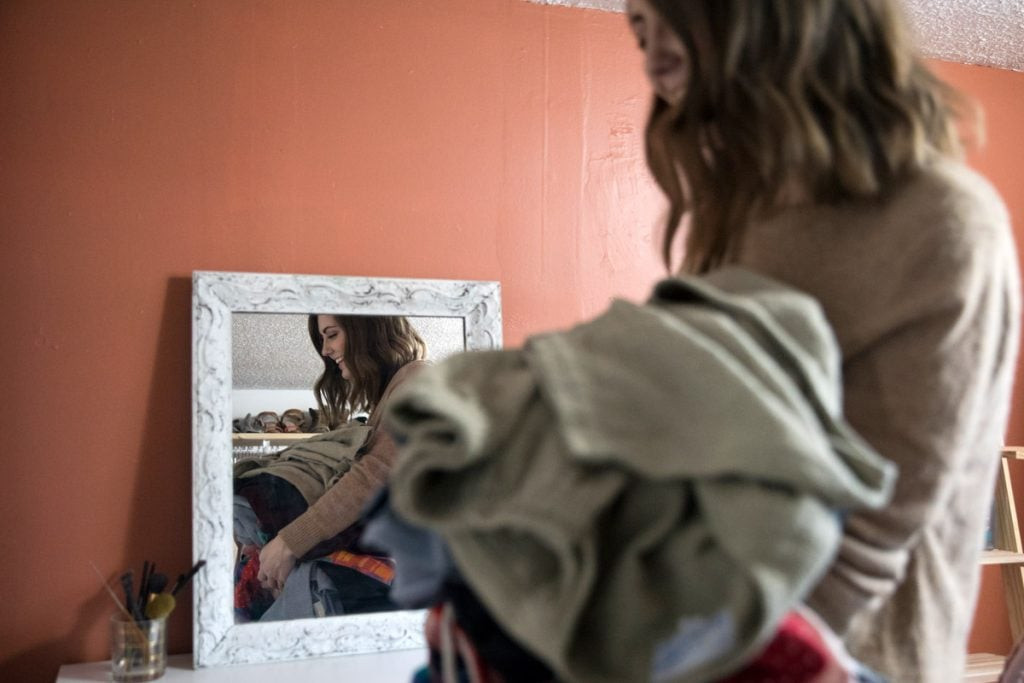 A woman carries piles of clothes to her bedroom to sort through.
A woman carries piles of clothes to her bedroom to sort through.
Alt Text: Woman sorting through luxury clothes to sell on The RealReal for high returns.
The RealReal is another platform specializing in luxury consignment, focusing on high-end clothing, jewelry, watches, handbags, and home goods. It’s designed for sellers looking to get top dollar for their valuable items.
Fees & Commission: The RealReal operates on a commission basis, with payout percentages increasing based on the item’s selling price and your annual sales volume. Commission rates vary by category, with collectibles, watches, men’s sneakers, and handbags typically earning higher percentages. For items under $200, commission is generally between 20% and 45%. Higher annual sales can unlock higher commission tiers.
Shipping & Logistics: The RealReal offers convenient options: at-home pickup, free shipping labels, and drop-off locations in New York City. They handle authentication, photography, listing, and pricing.
Pros:
- Luxury Expertise: Specialized in luxury goods, with expert authentication and pricing.
- High Commission Potential: Potential for higher payouts compared to general consignment, especially for valuable items and high-volume sellers.
- Full-Service Consignment: The RealReal handles all aspects of the selling process.
Cons:
- Luxury Focus: Strictly for high-end items, not suitable for everyday clothing brands.
- Commission-Based: Payouts are a percentage of the selling price, impacting net earnings.
- Authentication Process: Items must pass authentication, and may be rejected if deemed not authentic or not in suitable condition.
Best for: Sellers with authentic luxury clothing, jewelry, watches, and handbags seeking a full-service consignment experience and aiming to maximize returns on high-value items.
7. Mercari: Easy Listing for Almost Anything
 A woman
A woman
Alt Text: Woman holding clothes, representing selling used clothes for cash on Mercari.
Mercari is a user-friendly marketplace known for its broad acceptance of items – “you can list almost anything that can ship.” It’s a more hands-off platform that puts sellers in control of listing and pricing.
Fees: Mercari charges a flat 10% selling fee and a payment processing fee.
Shipping: Sellers can choose their shipping method: ship independently, use prepaid labels purchased through Mercari, or use Mercari Local for local buyers. Sellers are required to ship within three days of purchase. Payment is released after the buyer receives and rates the transaction.
Pros:
- Simplicity: Easy to list items, with seller-controlled pricing and descriptions.
- Broad Item Acceptance: Accepts a wide range of items beyond just clothing.
- Flexible Shipping: Multiple shipping options to suit seller preferences.
Cons:
- Seller Responsibility: Sellers are responsible for photography, descriptions, and customer service.
- Fees: 10% selling fee plus processing fees can impact profit margins.
- Less Authentication: Less emphasis on authentication compared to luxury-focused platforms, potentially attracting counterfeit items.
Best for: Sellers who want a simple, straightforward platform to quickly list and sell a variety of items, including clothing, and prefer control over the selling process.
8. Facebook Marketplace: Local Selling & Community
 A man holds a phone while logging into the Facebook app.
A man holds a phone while logging into the Facebook app.
Alt Text: Man using Facebook Marketplace app on his phone to sell used clothes locally.
Facebook Marketplace is integrated directly into the Facebook app, leveraging its vast user base for local buying and selling. It’s a convenient option for reaching local buyers in your community.
Fees: Facebook Marketplace charges a selling fee of 10% or a minimum of $0.80 per order, deducted automatically from transactions processed through Facebook.
Shipping & Transactions: Transactions are processed through Facebook, with fees and taxes automatically deducted. However, local pickups and cash transactions can bypass these fees.
Pros:
- Local Focus: Connects sellers with buyers in their local area.
- Ease of Use: Listing is as simple as creating a Facebook post.
- No Standalone App Needed: Integrated into the existing Facebook app.
Cons:
- Fees: 10% selling fee can apply to transactions processed through Facebook.
- Local Audience Limitation: Primarily reaches local buyers, limiting potential reach compared to global platforms.
- Safety Considerations: Requires caution when meeting local buyers for in-person transactions.
Best for: Sellers who want to sell used clothes quickly and locally, prefer in-person transactions, and are comfortable using Facebook’s platform. Ideal for larger or bulkier items where shipping is less practical.
9. Vinted: Seller-Friendly with No Fees
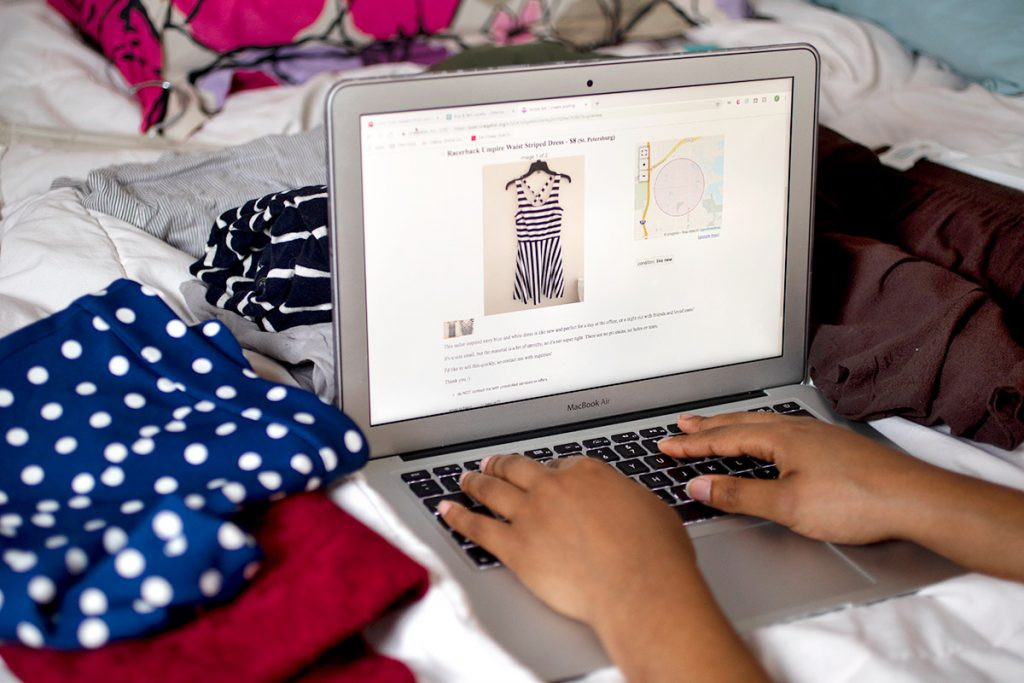 A woman uses a laptop to sell clothes online.
A woman uses a laptop to sell clothes online.
Alt Text: Woman selling clothes online using Vinted platform on her laptop.
Vinted is a popular platform known for its seller-friendly approach, most notably its lack of seller fees or commissions. It’s a casual marketplace focused on pre-loved fashion.
Fees: Vinted stands out by not charging sellers any listing fees or commission on sales. Buyers pay a buyer protection fee of 5% of the item price plus $0.70.
Shipping & Payment: Sellers list their items, and when sold, print a prepaid shipping label. Shipping is typically handled by the seller using Vinted’s provided label. Payout is received within two days of order completion via direct deposit to a Vinted Wallet.
Pros:
- No Seller Fees: Maximizes seller profits by eliminating listing and commission fees.
- Prepaid Shipping Labels: Simplifies the shipping process for sellers.
- User-Friendly App: Easy-to-use app for listing and managing sales.
Cons:
- Buyer Fees: Buyers pay a protection fee, which might deter some price-sensitive buyers.
- Lower Average Prices: Generally caters to a more budget-conscious market, potentially resulting in lower average selling prices.
- Seller Responsibility: Sellers are responsible for photography, descriptions, and shipping.
Best for: Sellers prioritizing maximizing their percentage return on sales, comfortable with handling shipping logistics, and targeting budget-conscious buyers in the pre-loved fashion market.
10. Depop: Trendy & Social Marketplace for Gen Z
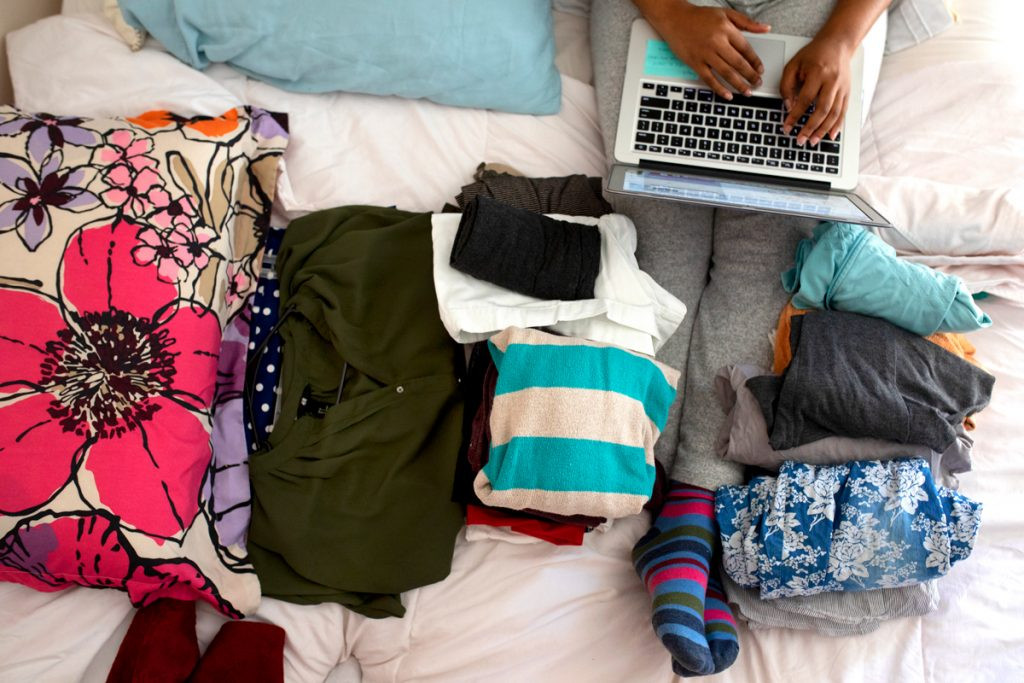 A woman types on a computer with clothes surrounding her that she
A woman types on a computer with clothes surrounding her that she
Alt Text: Fashionable woman selling trendy clothes online using Depop platform on her computer.
Depop is a fashion-focused social marketplace popular with Gen Z and younger millennials. It emphasizes visual appeal and community, making high-quality photos and unique staging essential.
Fees: Depop charges a 10% commission fee on sales, plus a transaction fee of around 3.49% + $0.49 for US-based sellers. There are no listing fees.
Shipping & Payment: Sellers can choose their shipping method, either using Depop’s prepaid labels or independent shipping. Payment is processed through Depop Payments (direct deposit) or PayPal.
Pros:
- Trendy Audience: Targets a younger, fashion-forward demographic.
- Social and Visual: Platform encourages creative presentation and community building.
- User-Friendly App: Easy to set up and use, with Depop Payments integration.
Cons:
- Fees: 10% commission plus transaction fees can impact profit margins.
- Visual Focus: High-quality photography and styling are crucial for success.
- Competition: Competitive marketplace requiring effort to stand out visually.
Best for: Fashion-savvy sellers, particularly Gen Z and younger millennials, with trendy clothing items, strong visual presentation skills, and who thrive in a social marketplace environment.
11. Whatnot
 A woman uses the Marie Kondo method to organzie her clothing on her bed.
A woman uses the Marie Kondo method to organzie her clothing on her bed.
Alt Text: Woman organizing clothes using Marie Kondo method, preparing to sell on Whatnot live auction platform.
Whatnot is a unique platform that utilizes live auctions for selling items, including clothing. It’s a social marketplace that combines entertainment with selling.
Fees: Whatnot charges an 8% commission fee on sales.
Auction Format: Sellers schedule live shows, present items on camera, and auction them off in real-time to viewers. Minimum prices and time limits can be set for auctions.
Shipping & Payment: Sellers ship items after the live auction. Payment is typically received within 72 hours after delivery through the Seller Hub, which also allows for generating shipping labels. Flat-rate shipping options are available.
Pros:
- Live Auction Format: Engaging and interactive selling experience, potentially driving higher prices through competitive bidding.
- Social Marketplace: Builds community and direct interaction with buyers during live shows.
- Seller Hub & Shipping Tools: Provides tools for managing shipping and payments.
Cons:
- Live Show Requirement: Requires comfort with being on camera and presenting items live.
- Time Commitment: Scheduling and conducting live shows requires dedicated time.
- Niche Platform: Less mainstream than some other marketplaces, potentially smaller audience reach.
Best for: Sellers comfortable with live video, who have unique or collectible clothing items that could perform well in an auction format, and enjoy interacting directly with buyers in real-time.
Where to Sell Used Clothes In Person
For those who prefer a more hands-on approach or want cash immediately, brick-and-mortar stores offer a convenient way to sell used clothes in person.
12. Buffalo Exchange
 a woman
a woman
Alt Text: Woman shopping at Buffalo Exchange store, a place to sell and buy used clothes in person.
Buffalo Exchange is a well-established resale chain with a long history in the used clothing market. They focus on reusing and recycling clothes and often partner with local charities.
Selling Process: Bring your clothes and ID to a Buffalo Exchange store. They will assess your items and offer you 25% of their selling price in cash or 50% in-store credit on the spot.
Accepted Items: Buffalo Exchange accepts a wide variety of men’s and women’s clothing, including vintage, activewear, and plus sizes.
Pros:
- Immediate Cash or Store Credit: Get paid instantly for accepted items.
- Wide Range of Items Accepted: Accepts diverse styles and categories of clothing.
- Eco-Conscious: Supports sustainable fashion and reduces textile waste.
Cons:
- Lower Payout Percentage: 25% cash payout is lower than potential online earnings.
- In-Store Visit Required: Requires physically visiting a store location.
- Selective Buying: Store buyers are selective and may not accept all items.
Best for: Sellers who want immediate cash or store credit, have a variety of clothing styles to sell, and prefer an in-person selling experience.
13. Clothes Mentor
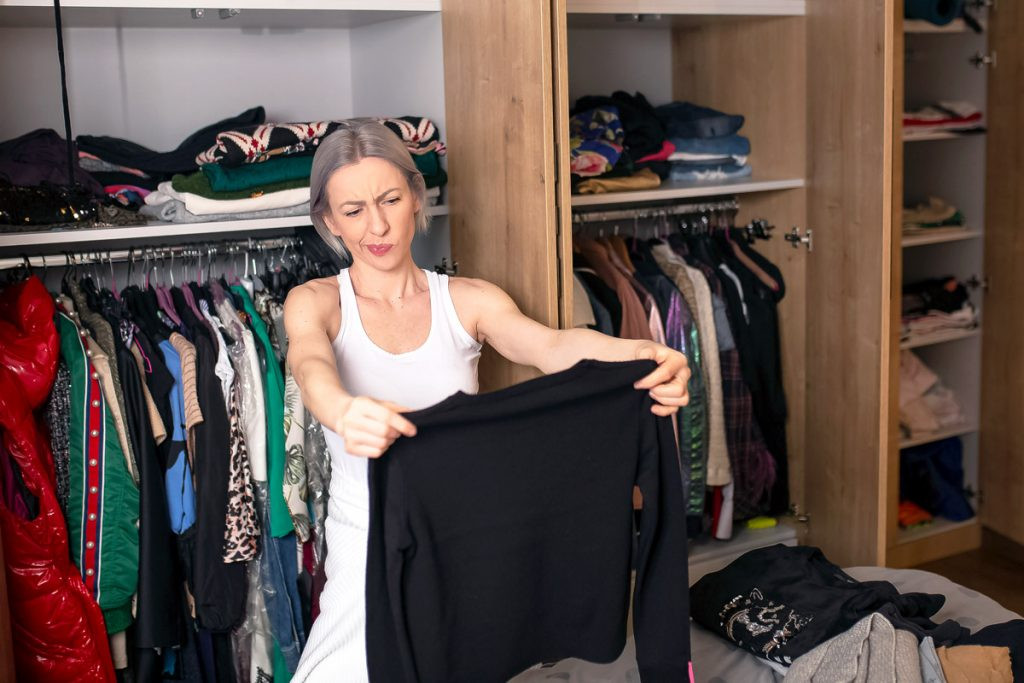 A woman sorts through her wardrobe.
A woman sorts through her wardrobe.
Alt Text: Woman sorting through fashionable wardrobe, preparing to sell to Clothes Mentor.
Clothes Mentor specializes in fashionable women’s clothing in sizes 0-26 and maternity wear, focusing on designer and brand-name items at accessible prices.
Selling Process: Bring your women’s clothing, shoes, accessories, jewelry, and handbags to a Clothes Mentor location. They buy items outright for cash on the spot if they meet their current demand and style preferences.
Accepted Items: They prefer brands like Lilly Pulitzer, Lululemon, and Louis Vuitton, and often look for specific trends and styles.
Pros:
- Cash on the Spot: Paid immediately for accepted items.
- Designer and Brand Focus: Good for selling fashionable, brand-name women’s clothing.
- Specialty Store: Caters specifically to women’s fashion needs.
Cons:
- Women’s Clothing Only: Limited to women’s apparel and accessories.
- Brand and Style Selective: Specific brand and style preferences influence buying decisions.
- In-Store Visit Required: Requires visiting a Clothes Mentor store location.
Best for: Women selling fashionable, brand-name clothing, shoes, and accessories in sizes 0-26 and maternity wear who want immediate cash.
14. Once Upon a Child
 parents shop for clothes with theiir young daughter.
parents shop for clothes with theiir young daughter.
Alt Text: Parents shopping with daughter at Once Upon a Child for used kids clothes and gear.
Once Upon a Child focuses on buying and selling used children’s clothes, baby gear, toys, and furniture. It’s a convenient option for parents looking to declutter and earn cash from outgrown items.
Selling Process: Bring your gently used children’s clothes (sizes preemie to youth 20), baby gear, toys, and furniture to a Once Upon a Child store. They buy items for cash on the spot if they meet their quality and safety standards.
Accepted Items: Children’s clothing (preemie to youth 20), cribs, strollers, baby electronics, toys, and Halloween costumes.
Pros:
- Cash on the Spot: Get paid immediately for accepted children’s items.
- Wide Range of Children’s Items: Accepts clothing, gear, toys, and furniture.
- Convenient for Parents: One-stop shop for buying and selling children’s items.
- Numerous Locations: Extensive store network across the US and Canada.
Cons:
- Children’s Items Only: Limited to children’s and baby items.
- Quality and Safety Standards: Items must meet their quality and safety criteria.
- In-Store Visit Required: Requires visiting a Once Upon a Child store location.
Best for: Parents selling used children’s clothes, baby gear, toys, and furniture who want immediate cash and a convenient local option.
15. Plato’s Closet
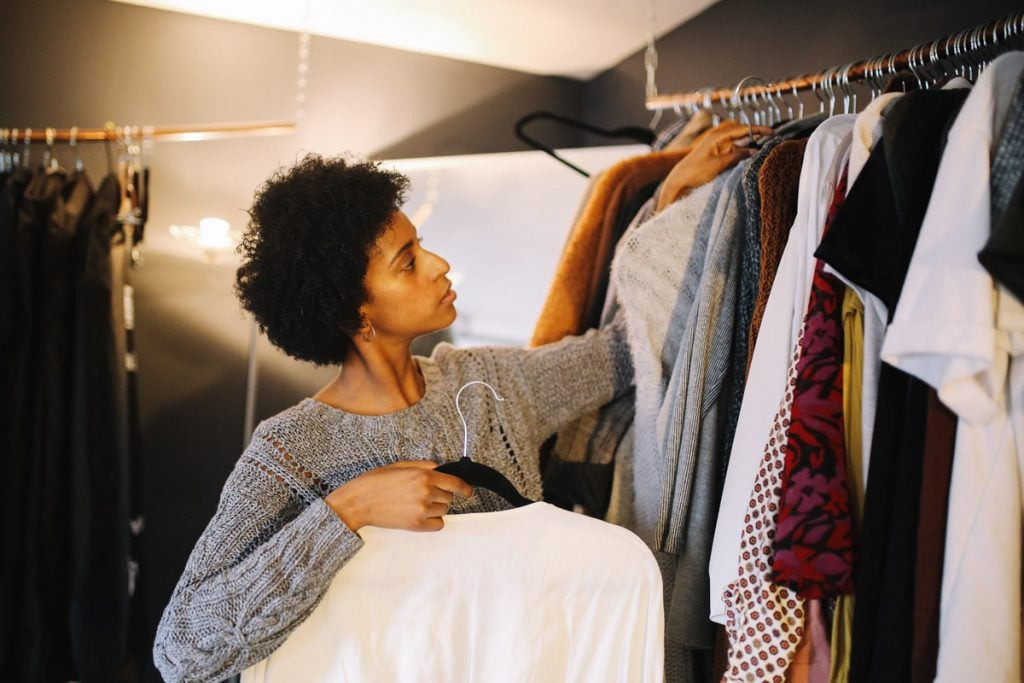 A woman sorts her clothing in her wardrobe.
A woman sorts her clothing in her wardrobe.
Alt Text: Young woman sorting trendy clothes for selling at Plato’s Closet.
Plato’s Closet targets teens and young adults, buying and selling trendy, everyday styles from popular brands. It’s a successful clothing exchange franchise with a large number of locations.
Selling Process: Bring your teen and young adult clothing, shoes, and accessories to a Plato’s Closet store. They buy items outright for cash on the spot if they align with current trends and their customer demand.
Accepted Items: Everyday styles from brands like Abercrombie & Fitch, American Eagle, Nike, H&M, athletic wear, shoes, and accessories. Bodysuits, skirts, and tanks are often in demand.
Pros:
- Cash on the Spot: Paid immediately for accepted items.
- Teen and Young Adult Focus: Specializes in trendy styles for this demographic.
- Popular Brands: Seeks in-demand brands popular with teens and young adults.
- Numerous Locations: Extensive store network across North America.
Cons:
- Teen/Young Adult Styles Only: Limited to clothing styles for this age group.
- Trend-Driven Buying: Buying decisions are heavily influenced by current trends.
- In-Store Visit Required: Requires visiting a Plato’s Closet store location.
Best for: Teens and young adults selling trendy, everyday clothing, shoes, and accessories from popular brands who want immediate cash.
16. Style Encore
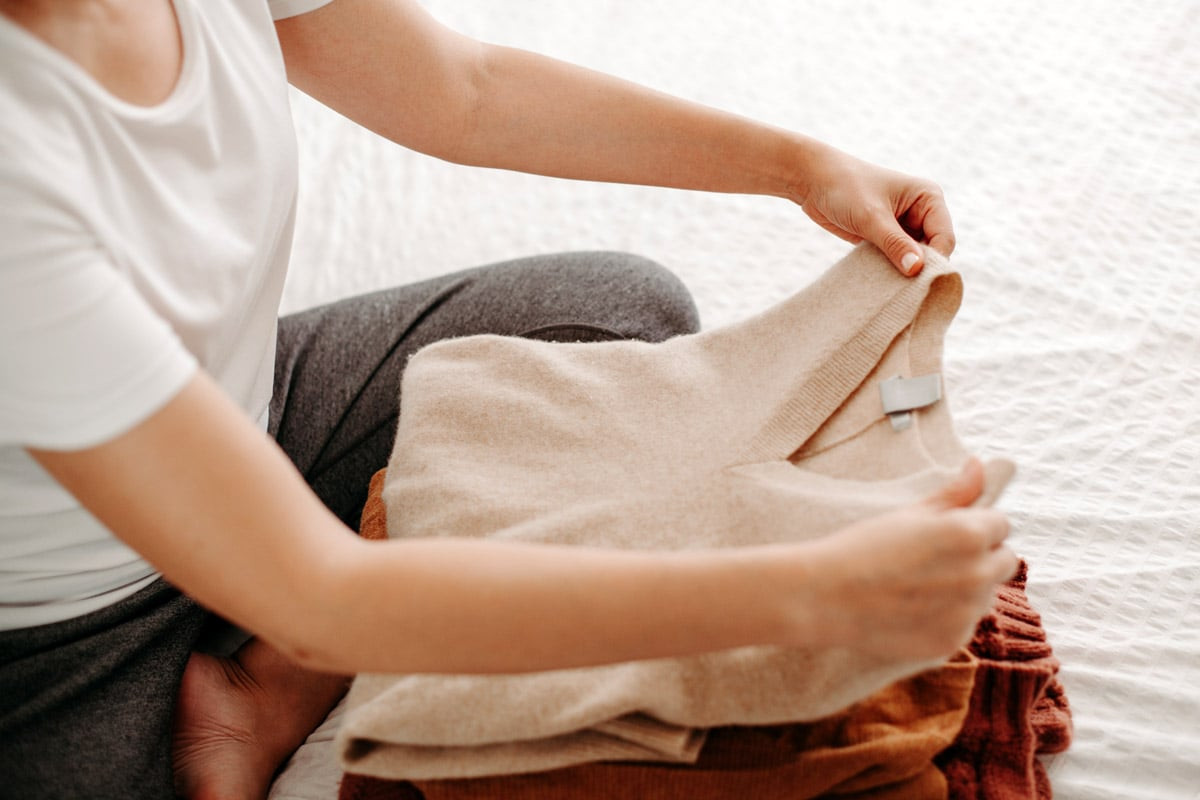 A woman folds her knitted sweaters.
A woman folds her knitted sweaters.
Alt Text: Woman folding fashionable sweaters, preparing to sell to Style Encore.
Style Encore, another Winmark brand, is similar to Plato’s Closet but targets slightly older and more sophisticated women’s apparel.
Selling Process: Bring your women’s clothing, shoes, handbags, and accessories from brands like Banana Republic, Calvin Klein, and Kate Spade to a Style Encore store. They buy items for cash on the spot if they meet their style and demand criteria.
Accepted Items: Women’s clothing from brands like Banana Republic, Calvin Klein, Coach, Kate Spade, shoes, handbags, and accessories.
Pros:
- Cash on the Spot: Paid immediately for accepted items.
- Sophisticated Women’s Styles: Focuses on more upscale women’s apparel.
- Personal Stylists: Some locations offer stylist services to enhance customer experience.
Cons:
- Women’s Clothing Only: Limited to women’s apparel and accessories.
- Brand and Style Selective: Specific brand and style preferences influence buying decisions.
- Fewer Locations: Newer brand with fewer store locations compared to other Winmark brands.
- In-Store Visit Required: Requires visiting a Style Encore store location.
Best for: Women selling more sophisticated, brand-name clothing, shoes, handbags, and accessories who want immediate cash and a store catering to a slightly more mature demographic than Plato’s Closet.
17. Uptown Cheapskate
 A woman looks through clothing on a store rack.
A woman looks through clothing on a store rack.
Alt Text: Woman shopping for clothes at Uptown Cheapskate, a trendy used clothing store.
Uptown Cheapskate is a trendy boutique-style resale store targeting young adults, offering a mix of thrift store prices and boutique style.
Selling Process: Bring your men’s and women’s clothing to an Uptown Cheapskate store. They offer 25% to 35% of the item’s price in cash or around 50% in store credit for items they accept. High-end items like Chanel and Louis Vuitton can earn up to 60% cash.
Accepted Items: Trendy men’s and women’s clothing, including brands like Madewell, Nordstrom, and Old Navy. Good condition is essential – no damage, tears, or stains. Trending styles like hoodies, loose-fit denim, and shackets are often sought after.
Pros:
- Cash or Store Credit Options: Offers both cash and higher-value store credit payouts.
- Trendy Boutique Style: Appeals to young adults seeking fashionable and affordable clothing.
- Higher Payout for Luxury Items: Offers better cash percentages for high-end brands.
Cons:
- Condition Requirements: Strict requirements on clothing condition – must be in excellent shape.
- Brand and Style Selective: Focuses on trendy brands and styles, may not accept all items.
- In-Store Visit Required: Requires visiting an Uptown Cheapskate store location.
Best for: Young adults selling trendy, brand-name clothing in excellent condition who want cash or store credit and a boutique-like resale experience.
18. Crossroads Trading
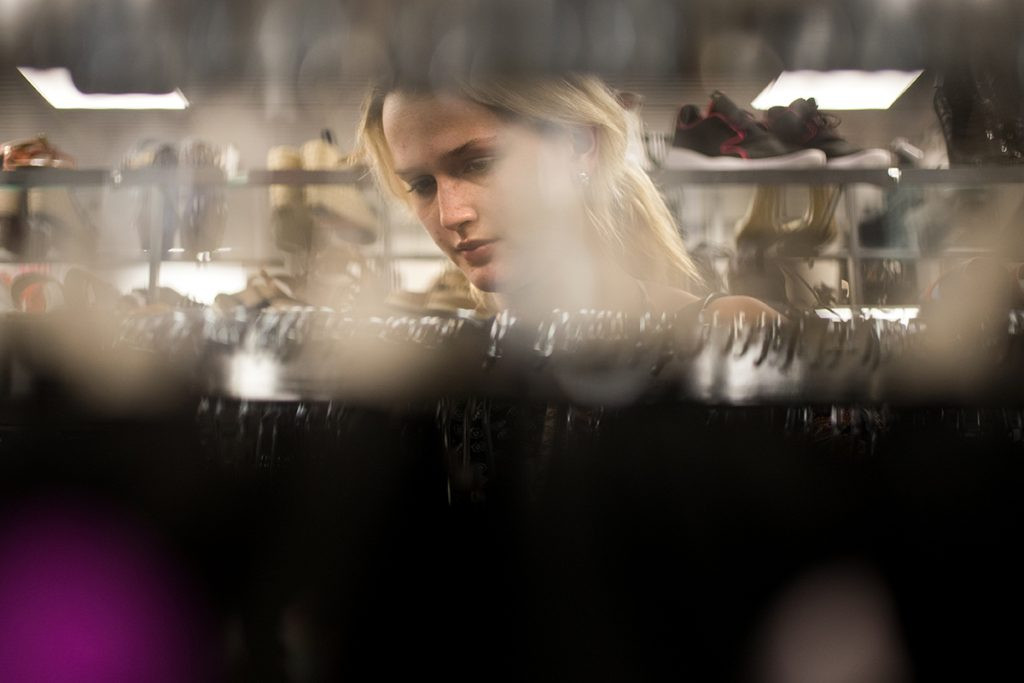 A woman shops for clothing at Upscale Cheapskate, a trendy thrift store.
A woman shops for clothing at Upscale Cheapskate, a trendy thrift store.
Alt Text: Woman shopping at Crossroads Trading, a fashion-forward used clothing store.
Crossroads Trading is a fashion-forward resale store, similar to Buffalo Exchange and Uptown Cheapskate, focusing on trendy and name-brand items.
Selling Process: Bring your clothes to a Crossroads Trading store. They offer 50% of their store price in store credit or 30% in instant cash for accepted items.
Accepted Items: Trendy and name-brand clothing, currently seeking styles like country prep, modern utility, and elevated everyday.
Pros:
- Cash or Store Credit Options: Offers both cash and higher-value store credit payouts.
- Fashion-Forward Focus: Specializes in trendy and stylish clothing.
- Name-Brand Preference: Values name-brand items.
Cons:
- Trend-Driven Buying: Heavily influenced by current fashion trends.
- In-Store Visit Required: Requires visiting a Crossroads Trading store location.
- Selective Buying: Buyers are selective based on current trends and store demand.
Best for: Sellers with trendy, fashion-forward clothing from name brands who want cash or store credit and a store that prioritizes current styles.
19. Bonus: Local Consignment Shops
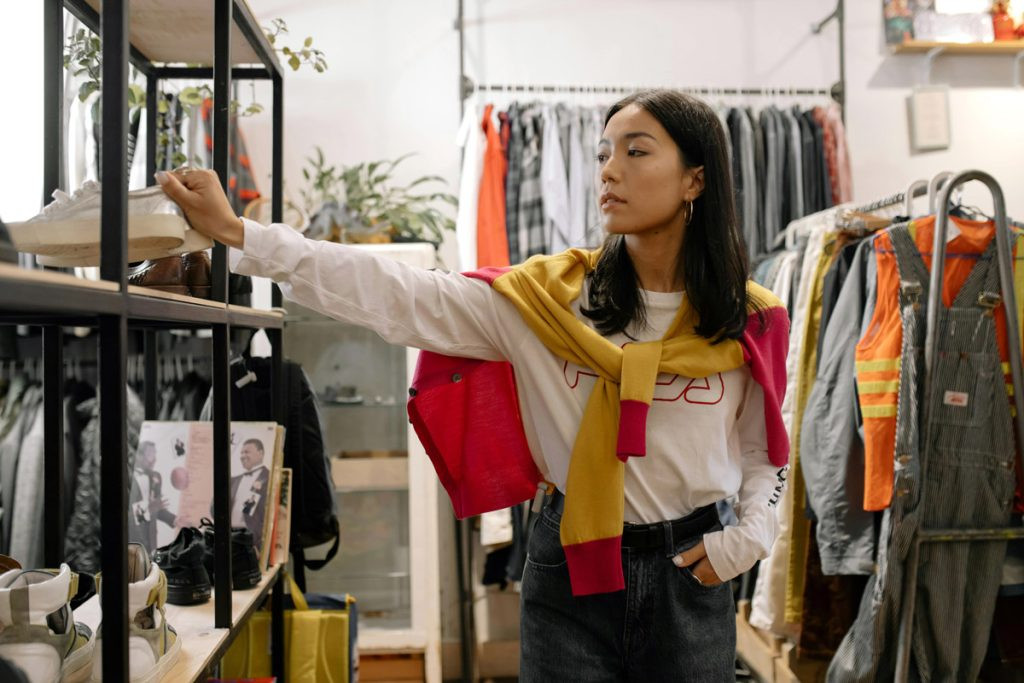 A woman shops in a thrift store for presents.
A woman shops in a thrift store for presents.
Alt Text: Woman shopping for presents in a local consignment shop, an alternative for selling used clothes.
Local consignment shops offer a more personalized and community-based option for selling used clothes. They operate differently from clothing exchange stores.
Selling Process: Consignment shops typically don’t pay upfront. They sell your items and then pay you a percentage of the sale price once the item sells. You may need to make an appointment to show your clothes.
Accepted Items: Varies widely by store, often based on personal taste, season, and local demand.
Pros:
- Potential for Higher Payouts (Consignment Percentage): Consignment percentages can sometimes be higher than immediate cash offers from clothing exchange stores.
- Personalized Service: Often offer a more personal and curated shopping experience.
- Community Focus: Supports local businesses and community-based shopping.
Cons:
- Payment Upon Sale: You don’t get paid until your items sell, which can take time.
- Unpredictable Sales: Sales depend on store traffic and item appeal.
- Appointment May Be Needed: May require scheduling an appointment to bring in clothes.
- Brand and Style Variability: Brand and style preferences vary significantly between local stores.
Best for: Sellers who are patient and not in immediate need of cash, have unique or higher-value items that might do well in a consignment setting, and prefer supporting local businesses.
Tips to Maximize Your Earnings When Selling Used Clothes
Regardless of where you choose to sell, following these tips can help you get the most cash for your used clothes.
Clean and Prepare Your Clothes
 A woman folds her knitted sweaters.
A woman folds her knitted sweaters.
Alt Text: Woman neatly folding clean knitted sweaters, preparing clothes for sale.
Always wash and clean your clothes before selling them, whether online or in person. Clean, fresh-smelling clothes make a much better impression. For in-person stores, associates will be inspecting your items closely, and cleanliness is key to getting accepted. Wrinkled clothes can also appear unwashed, so ensure you fold or iron them neatly.
Presentation Matters: Use a Nice Basket
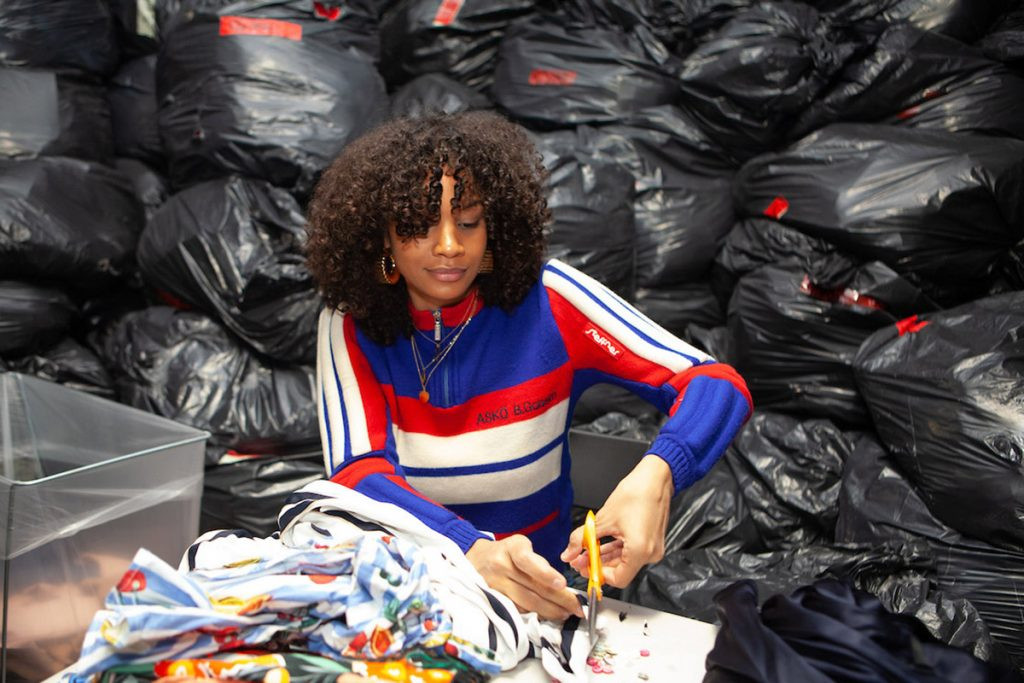 A woman cuts into clothing with bags of clothing behind her in trash bags.
A woman cuts into clothing with bags of clothing behind her in trash bags.
Alt Text: Woman upcycling clothes, contrasting presentation of clothes in bags versus nicely presented.
When selling in person, how you present your clothes matters. Avoid bringing clothes in trash bags, which can give a negative impression. Instead, use a clean basket, hamper, or box to carry your folded clothes. Presentation signals that you value your items and have taken care of them.
Inspect for Damage or Pit Stains
 A woman hangs upside down on her bed while looking perplexed with clothes surrounding her.
A woman hangs upside down on her bed while looking perplexed with clothes surrounding her.
Alt Text: Perplexed woman surrounded by clothes, highlighting the need to inspect for damage before selling used clothes.
Before listing online or taking clothes to a store, carefully inspect each item under bright light. Check for tears, stains (especially pit stains), missing buttons, broken zippers, or fading. Damaged or stained clothing is unlikely to be accepted and can negatively impact your reputation as a seller. Online platforms may return unacceptable items to you, incurring extra hassle.
Sell Seasonally and Regularly
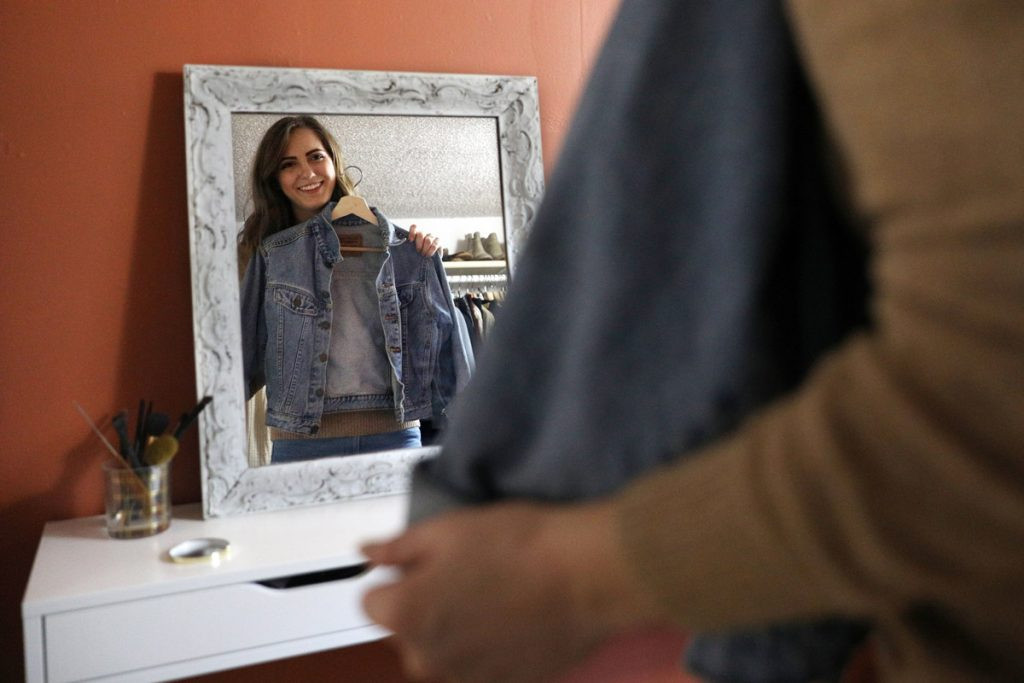 A woman smiles at her jean jacket as she sorts through clothing at her home.
A woman smiles at her jean jacket as she sorts through clothing at her home.
Alt Text: Smiling woman sorting through clothes, emphasizing selling clothes seasonally and regularly for cash.
Clothing resale stores buy based on seasons and current trends. Selling seasonally maximizes your chances of acceptance and potentially higher payouts. For example, sell winter coats in the fall and summer dresses in the spring. Buffalo Exchange recommends selling clothes every three months to keep your wardrobe current and maximize your selling potential. If you live in a warmer climate, seasonal timing might be less critical, but consider selling items that are currently in demand.
Start Selling Your Used Clothes for Cash Today!
Selling used clothes for cash is a smart way to declutter, earn money, and participate in sustainable fashion. With numerous online and in-person platforms available, you can choose the method that best suits your needs and preferences. Whether you opt for the convenience of online marketplaces, the immediate cash of brick-and-mortar stores, or the personalized approach of consignment shops, remember that preparing your clothes well and understanding the platform’s specific requirements are key to success. So, take a look through your closet, identify those items you no longer wear, and start turning your used clothes into cash today!

